by Ian Skellern
Welcome to the 2019 edition of Quill & Pad’s early Grand Prix d’Horlogerie de Genève predictions in which the team picks favorites and explains why.
The panelists are:
Ian Skellern (IS), co-founder and technical director
Joshua Munchow (JM), resident nerd writer
Martin Green (MG), resident gentleman
Sean Li (SL), editorial director of Blackbird Watch Manual
Tim Mosso (TM), watch specialist and media director of pre-owned watch retailer Watchbox
Note: as jury members, editor-in-chief Elizabeth Doerr and resident collector GaryG do not take part in these early predictions.
The GPHG foundation describes the Chronograph category for watches entered as “mechanical watches comprising at least one chronograph indication; additional indications and/or complications are admissable.”
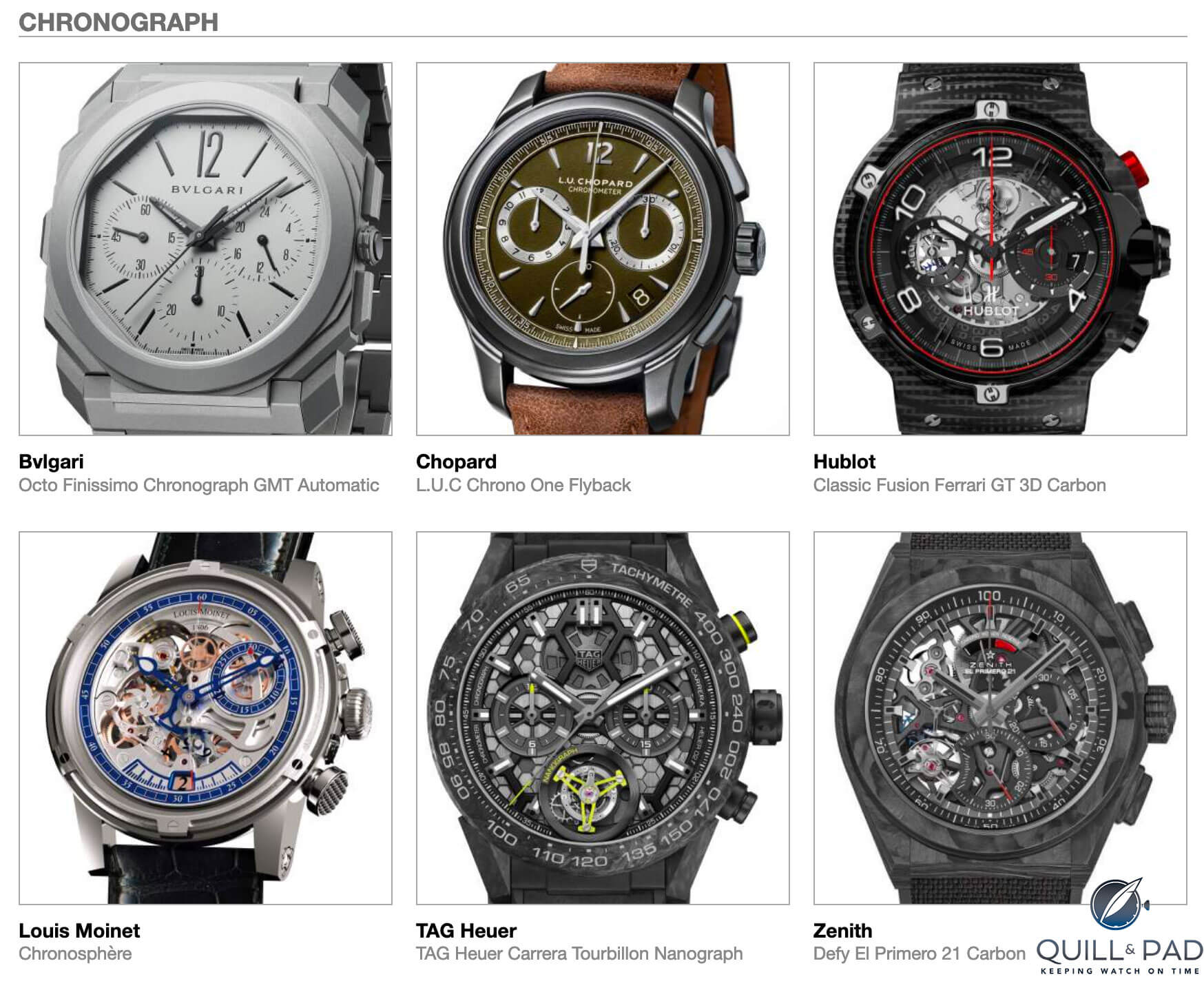
Shortlisted Chronograph watches in the 2019 GPHG (from top left): Bulgari Octo Finissimo Chronograph GMT Automatic, Chopard L.U.C Chrono One Flyback, Hublot Classic Fusion Ferrari GT 3D Carbon, Louis Moinet Chronosphère, TAG Heuer Carrera Tourbillon Nanograph, and Zenith Defy El Primero 21 Carbon
MG: It’s funny, but none of the watches competing in the Chronograph category are made of steel; I guess this is a clear sign of our time. The design of each and every one of them is also very powerful.
IS: Yes, it is interesting this year thanks to the mix of the old and the new, Martin. And it looks to me like 2019 is the year of “carbon chronographs” as 50 percent of the pre-selected watches here sport carbon fiber cases. It should also be noted that we have both a silicon escapement (Hublot) and a carbon composite hairspring (TAG Heuer) in this group.
JM: Today we cover the Chronograph category, and I am pleasantly surprised at the quality of the entries. Nearly all of them could win if the competition hadn’t brought their A-games. Incredibly, many did, and this category could go a variety of ways.
We are looking at watches that feature groundbreaking material science, world records, and ultra-high-frequency timing as well as expertly classic and avant-garde engineering. Depending on what you think is the most important aspect of the chronograph and what you feel changes the game more, this competition has no easy winner. Sometimes this is due to nothing being a standout, but this year there are many.
I have my favorite, but I will probably be happy if one of four wins, and might only strongly disagree if another takes the top spot. I guess that we will have a split decision among ourselves, so I am excited to see how everyone breaks this category down!
SL: I’m genuinely surprised that there weren’t more chronographs put forward this year; it’s a pretty well accepted and accessible complication for lack of a better word, one of the most mainstream (other than “basic” complications like the date). The GPHG rules don’t really help in making a selection because this category’s definition is rather short and sweet, which makes it rather broad.
TM: This category has two standouts: the Bulgari and the Hublot. Both are inventive, attractive, horologically refined, and fresh. The remainder of the nominees simply attempt to do too much or too little.
Bulgari Octo Finissimo Chronograph GMT Automatic
SL: Yet another Gérald Genta-influenced design, which Bulgari has adopted and done an admirable job of making a signature look. The Octo Finissimo is interesting when you consider how thin it is while still integrating the chronograph and GMT functions with automatic winding to boot. It’s tough to find fault here.
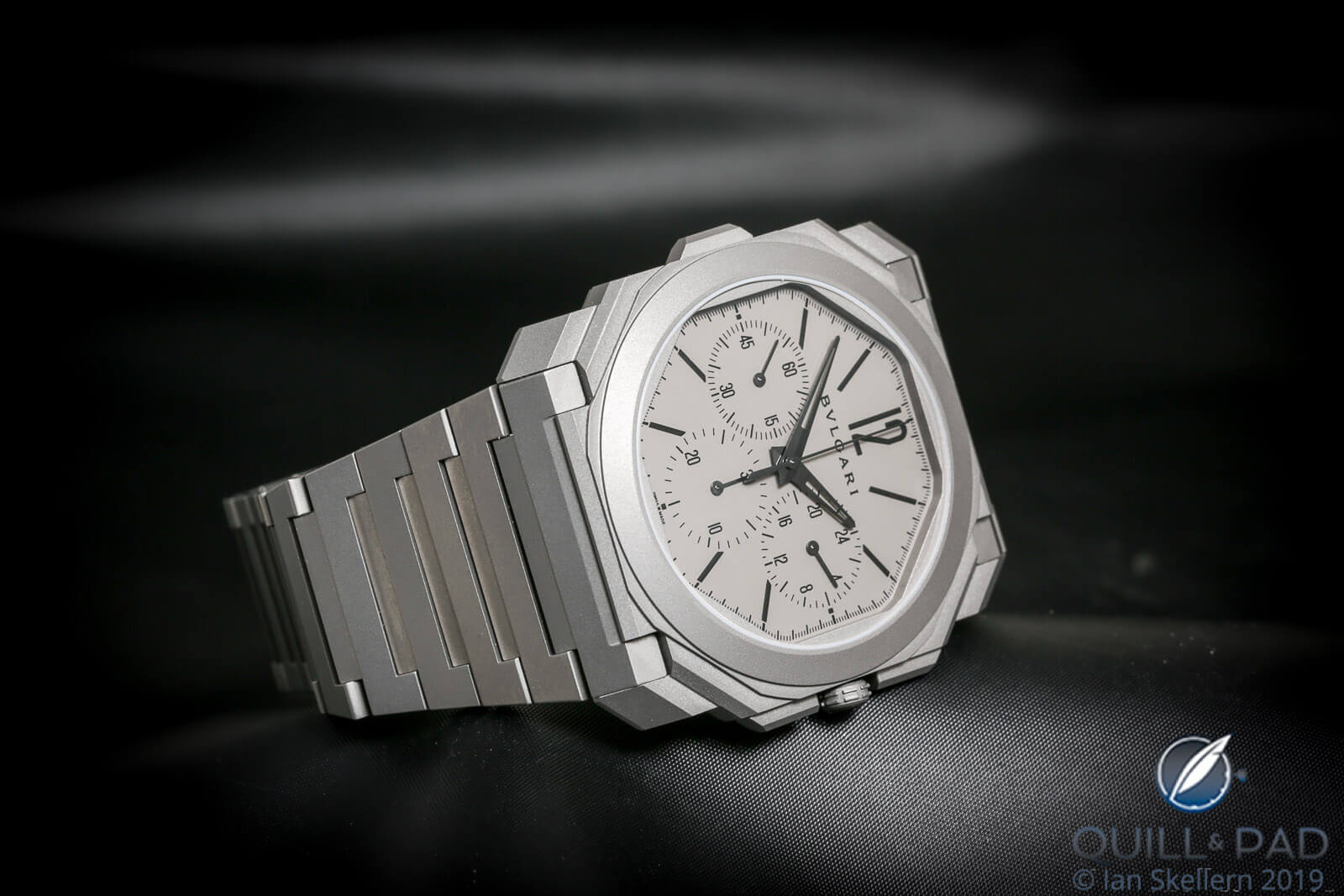
Bulgari Octo Finissimo Chronograph GMT Automatic
TM: Bulgari needs to win this category. The buzz around the Octo Finissimo line is not fading with time, and each model year brings a new breakthrough. The 2019 Chronograph GMT combines the best elements of the Octo Finissimo Automatic, winner of the 2017 Men’s prize, with a new movement that should forever banish any lingering prejudice about Bulgari’s fashion-brand roots. At 6.9 mm sapphire to sapphire, this automatic-winding multi-complication remains freakishly thin and carries only 1.75 mm more girth than the original Automatic. Remember: that was the world’s thinnest automatic watch when launched!
There was nothing broken about the Gérald Genta hand-me-down Octo shape, so Bulgari wisely left that alone here. The dial changed to accommodate the chronograph, and the designers did well to maintain balance by hiding the GMT dial at 3 o’clock.
This movement is glorious. Rather than graft a chronograph module to the previous automatic Caliber BVL 138, Bulgari reached upmarket and appropriated the peripheral winding system from its BVL 288 tourbillon movement. All chronograph guts sit within the “donut hole” created by the circumferential winding gear. The darn thing even stuffs a 55-hour power reserve inside all of 3.3 mm’s worth of headroom, and a traditional column wheel function cycler is included. Finish is price-appropriate, and the GMT adjustment button at 9 o’clock is user friendly.
As a simple packaging exercise, the Octo Chronograph GMT deserves recognition. Add beauty, nuance, balance, refinement, and practicality, and you have a category winner. If Bulgari ever gains full footing as a luxury peer to companies like Blancpain, Zenith, and AP, we’ll cite the 2014-2019 Octo Finissimo rollout as the reason why.
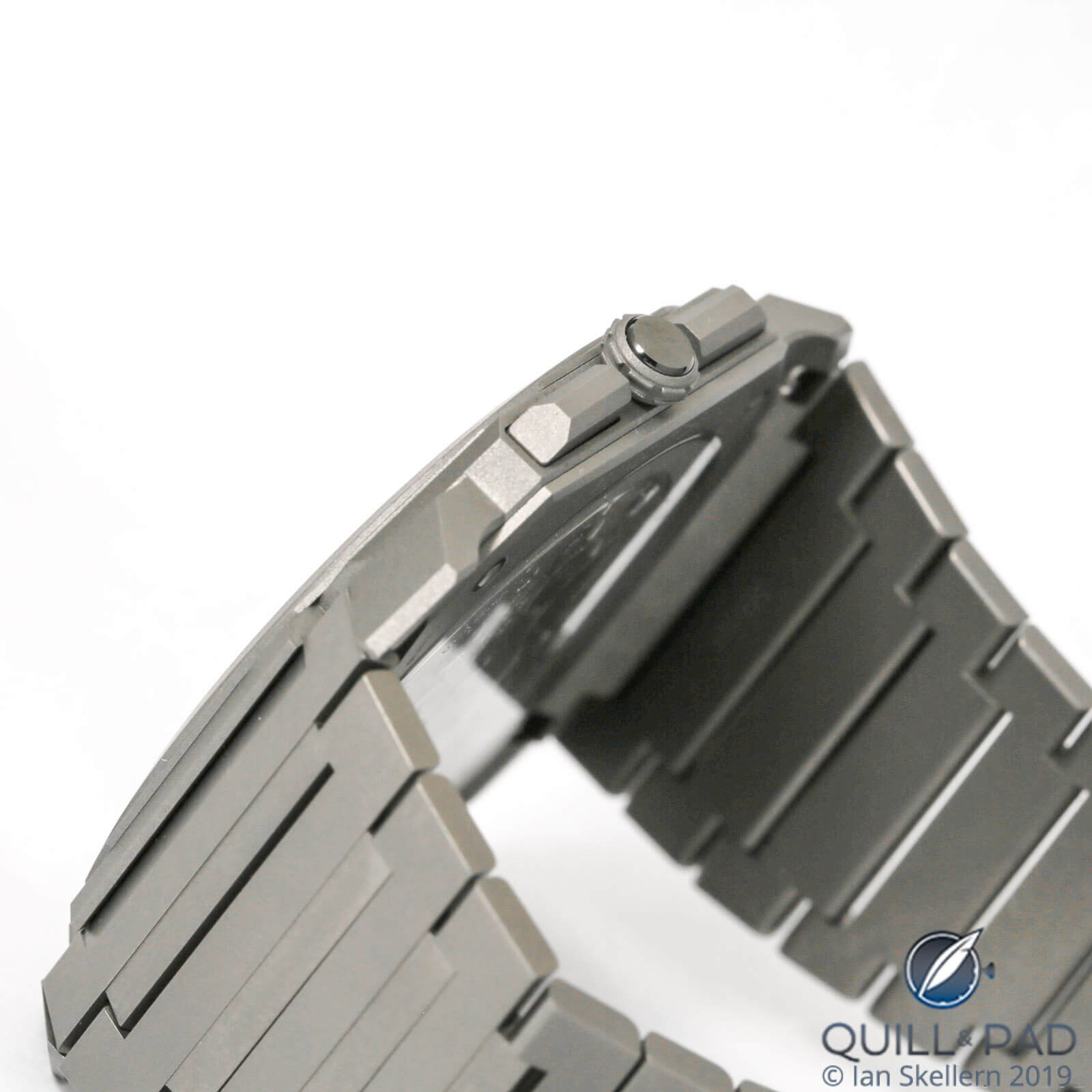
Only 6.9 mm in height: the Bulgari Octo Finissimo Chronograph GMT Automatic from the side
JM: Saying that Bulgari has an obsession with making things thin would be an understatement as it has been competing to achieve (and regularly winning) world records for the thinnest this and the thinnest that. The Octo Finissimo Chronograph GMT Automatic set the brand’s fifth world record as the thinnest mechanical chronograph in the world, not to mention that it is an automatic with peripheral rotor and has a GMT display in place of a chronograph hours.
The Octo Finissimo line has created many stars, and the incredible engineering behind the impressively thin movements has not gone unnoticed. This is a really hard decision not to pick it as the winner because thinning out movements is very hard past a certain point, but my winner edges it out with futuristic material innovation.
IS: One of the most challenging things about judging these pre-selected watches is both being aware of your own biases and (hopefully) allowing/adjusting for those biases. I’m an unashamed Bulgari Octo Finissimo fanboy, but I am still surprised at Bulgari’s rapidity and success in using the Octo Finissimo collection to transform itself in the eyes of watch aficionados from a jewelry brand that does watches to a serious watch brand.
The Octo Finissimo Chronograph GMT Automatic is not only the world’s thinnest mechanical chronograph, it has claimed that throne with a very wearable automatic movement with GMT and a 55-hour power reserve. Putting all my biases aside (fat chance), I’m predicting that the Bulgari Octo Finissimo Chronograph GMT Automatic will win the 2019 GPHG Chronograph category.
MG: Bulgari grabbed another world record with the Octo Finissimo Chronograph and added a GMT function into the mix for good measure. However, in terms of design, it is so close to the other Octo Finissimos that it simply doesn’t differentiate enough from its peers for me.
Further reading:
Bulgari Octo Finissimo Automatic: To Live With Is To Love
For more please visit gphg.org/horlogerie/en/watches/octo-finissimo-chronograph-gmt-automatic.
Quick Facts Bulgari Octo Finissimo Chronograph GMT Automatic
Case: 42 x 42 x 6.9 mm, titanium
Movement: ultra-thin automatic Caliber BVL 318, 28,800 vph/4 Hz frequency, 55-hour power reserve
Functions: hours, minutes, seconds; second time zone, chronograph
Price: $16,500
Chopard L.U.C Chrono One Flyback
SL: This is rather unexpected from Chopard. There are, in fact, two new versions of the L.U.C Chrono One this year: a more classical one in steel and this one with the titalyt case. There’s something very appealing with this piece, which is resolutely sporty, a size that I like, a bit of a military camouflage aspect to it. I’m just not sure whether it’s a little too left field for the GPHG jury coming from Chopard.
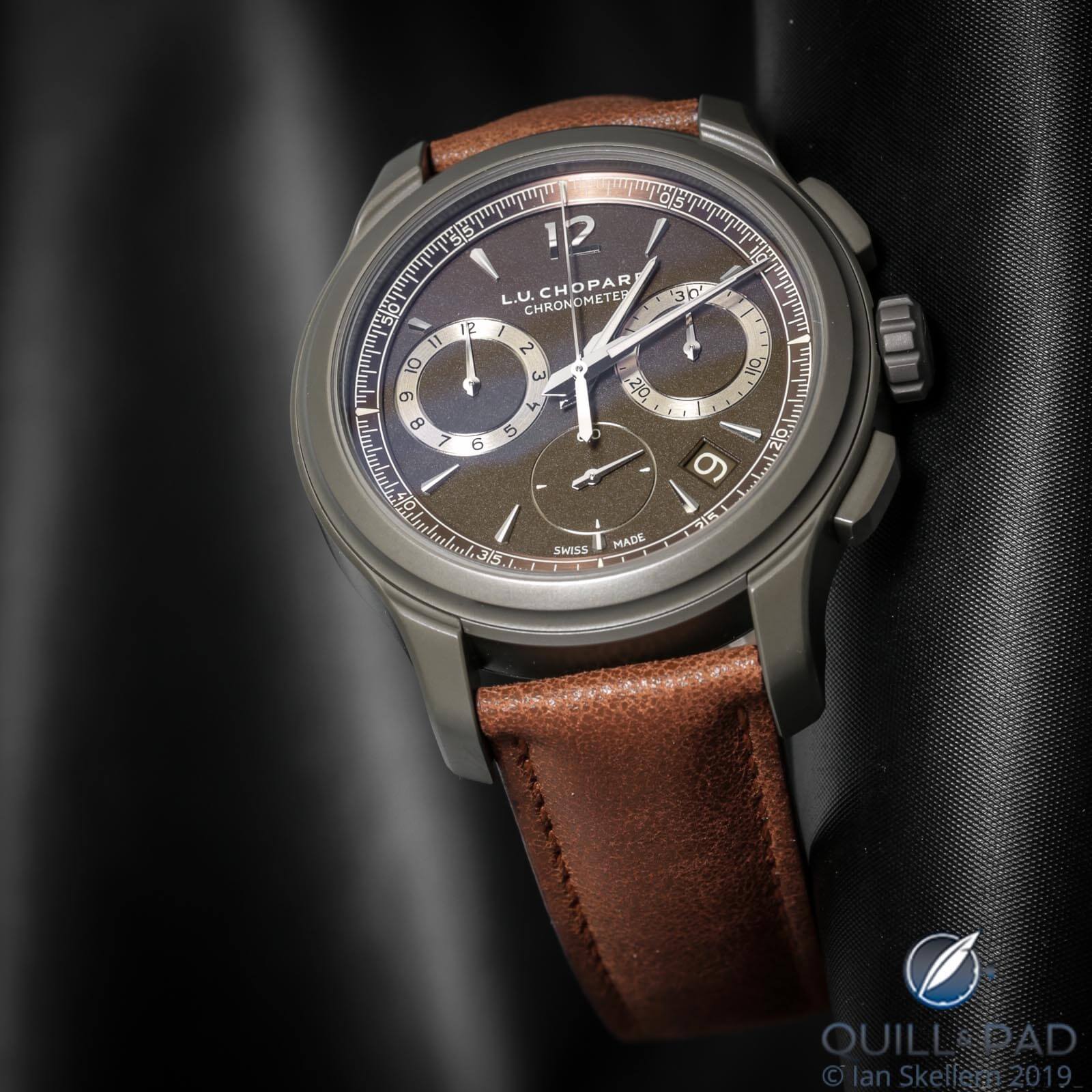
Chopard L.U.C Chrono One Flyback
TM: Chopard’s entry is the most competitive with the leaders, but it amounts to a mild re-dial of the existing Chrono One Flyback. The watch is more inoffensive than sexy, and there’s nothing materially new about the dial layout or caliber within. If this were the first time we had seen these elements together, the Chopard would be a top contender, but there’s nothing new here aside from the use of titalyt.
JM: Talk about the expert application of classic watchmaking principles: this is what defines any Chopard L.U.C watch, and the Chrono One Flyback is no exception. The styling, functionality, and engineering all combine to make a fantastic classic chronograph. It has everything that many would want in an everyday watch built to last.
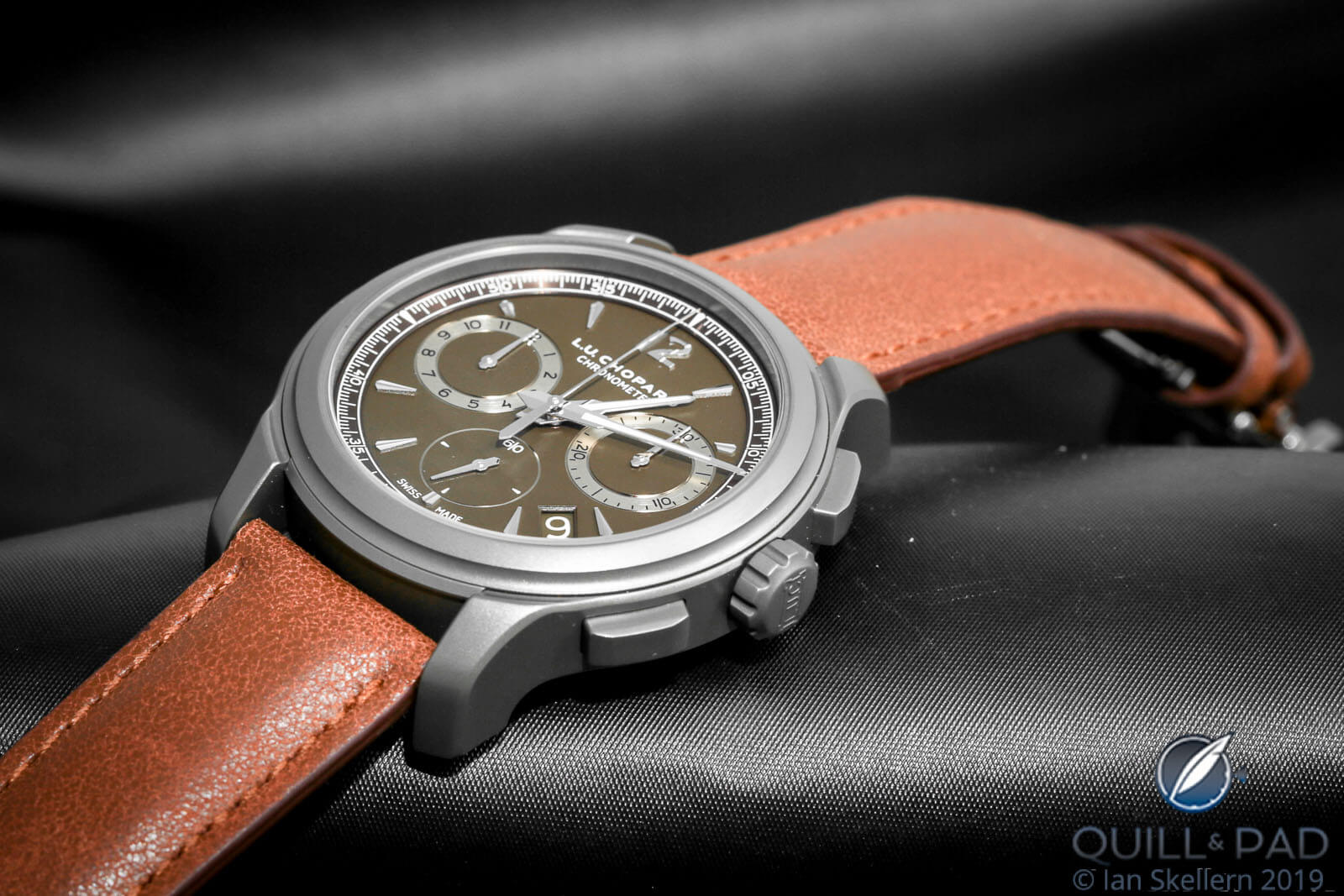
Chopard L.U.C Chrono One Flyback
IS: Developing an integrated (flyback) chronograph movement in-house is no easy task, Joshua, and Chopard has pulled off the feat superbly. No fewer than four patents attest to the innovation involved. But as nice as I think the subdued military green/brown dial looks, I think it will take even more to win this category.
JM: This is also the reason I don’t think it’s going to win the category: because it feels safe. It’s safely a great, all-around chronograph that probably will have admirers from all sides of the debate. Sometimes you need to be a bit polarizing to stand out. This is why I think this piece will miss the top spot as it lacks the definitive character to make people love it or hate it.
MG: I like how Chopard ever so subtly made the design of the L.U.C Chrono One Flyback as if the company is aiming it at a younger demographic.
For more please visit gphg.org/horlogerie/en/watches/luc-chrono-one-flyback.
Quick Facts Chopard L.U.C Chrono One Flyback
Case: 42 x 13.42 mm, titalyt
Movement: automatic Caliber L.U.C 03.03-L; 60-hour power reserve, 4 Hz/28,800 vph frequency
Functions: hours, minutes; flyback chronograph
Price: 28,200 Swiss francs
Hublot Classic Fusion Ferrari GT 3D Carbon
SL: This watch certainly needs to be seen in person because its three-dimensional aspect gives it a lot of personality, one that doesn’t come across in photos. It’s a great evolution of the Hublot and Ferrari partnership with more involvement from the latter’s design studio; it has a number of aesthetic cues that evoke the sports cars. I do find, though, that the design is maybe a little too far from Hublot itself, so I’m not sure who it’ll appeal to more, Ferrari enthusiasts or Hublot collectors.
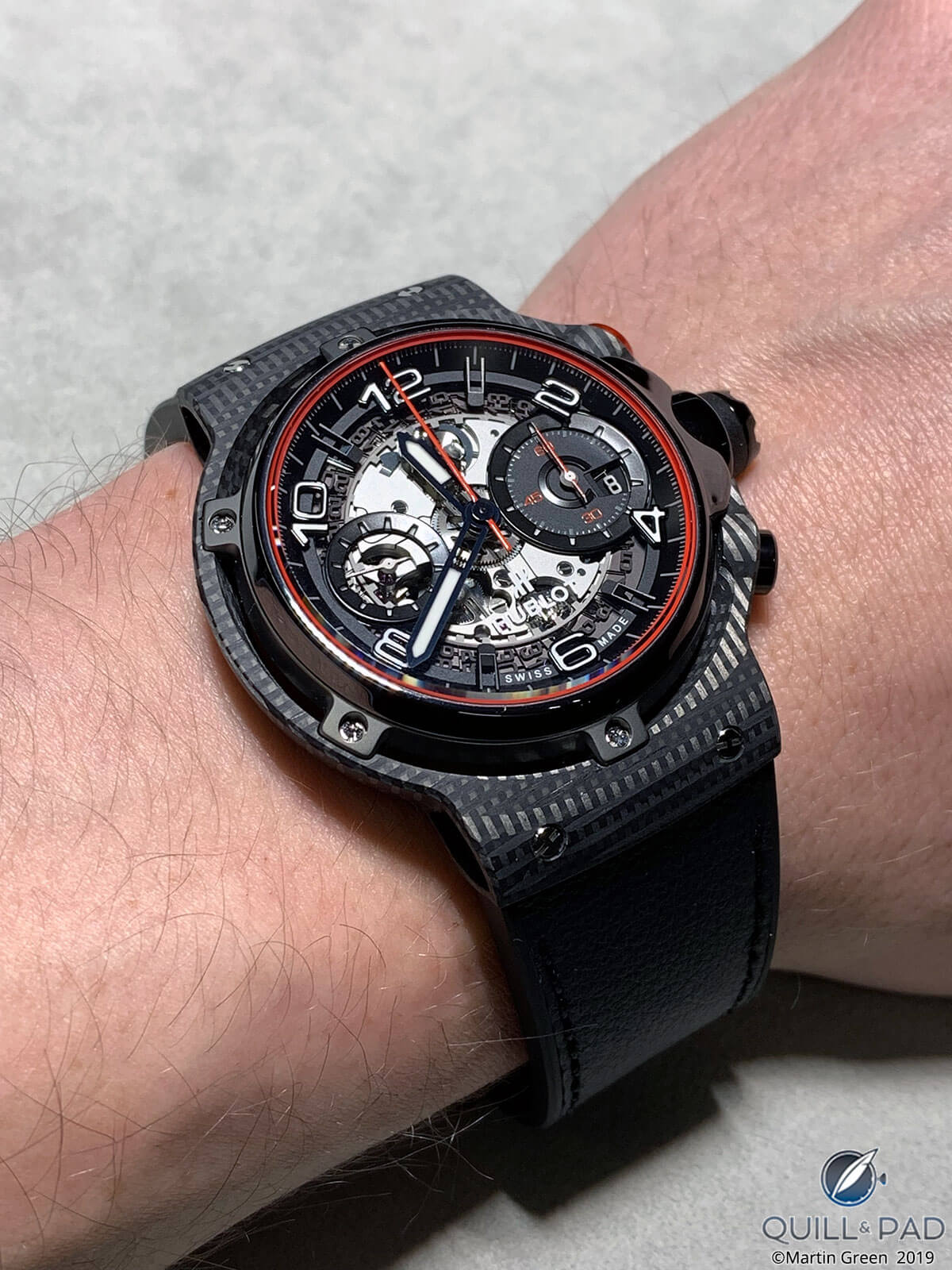
Hublot Classic Fusion Ferrari GT 3D Carbon on the wrist
IS: Hublot fans are not likely to be disappointed in the Hublot Classic Fusion Ferrari GT 3D Carbon as it features everything the brand is known for plus a flyback chronograph, carbon fiber case, association with Ferrari, and a silicon escapement. However, while the packaging is new the base movement has been around for a few years now, and I think that it will take something newer and fresher to win this category.
JM: The Hublot Classic Fusion Ferrari GT 3D Carbon is exactly what I have come to expect from Hublot: a boldly cool watch with high-tech materials and a sporty design. It utilizes everything that makes an Hublot an Hublot. It also feels like it lacks something specific to set it apart since other watches feature carbon fiber cases or a flyback chronograph, and there isn’t a specific feature that it really touts as groundbreaking or explicitly unique. It is clearly a great watch, but it just doesn’t feel like the 2019 Chronograph winner.
TM: Hublot’s Classic Fusion series has been eroding the dominance of the Big Bang for years, but the last three or so model years have witnessed the once entry-level collection achieve something like parity in Nyon’s product planning. With Classic Fusion volumes now rivaling those of the Big Bang, a watch like the Classic Fusion Ferrari GT 3D Carbon was inevitable; this watch was the moment that “Classic Fusion” grew up.
With a full-fledged Unico caliber and an ethereal 45 mm carbon atrium touted as Ferrari’s own design, the Classic Fusion Ferrari is no undercard. Compared to the Fusion Ferrari, the Big Bang Ferrari Unico looks heavy, overwrought, awkward, and unresolved.
Analogies to V8 and V12 Ferrari products fail; no V8 is intended to eclipse the appeal of any V12 offering, but that’s what happened with the Ferrari GT 3D Carbon. It’s gorgeous, the details impress as much as the whole, and it flirts with a quality rarely ascribed to any Hublot: beauty.
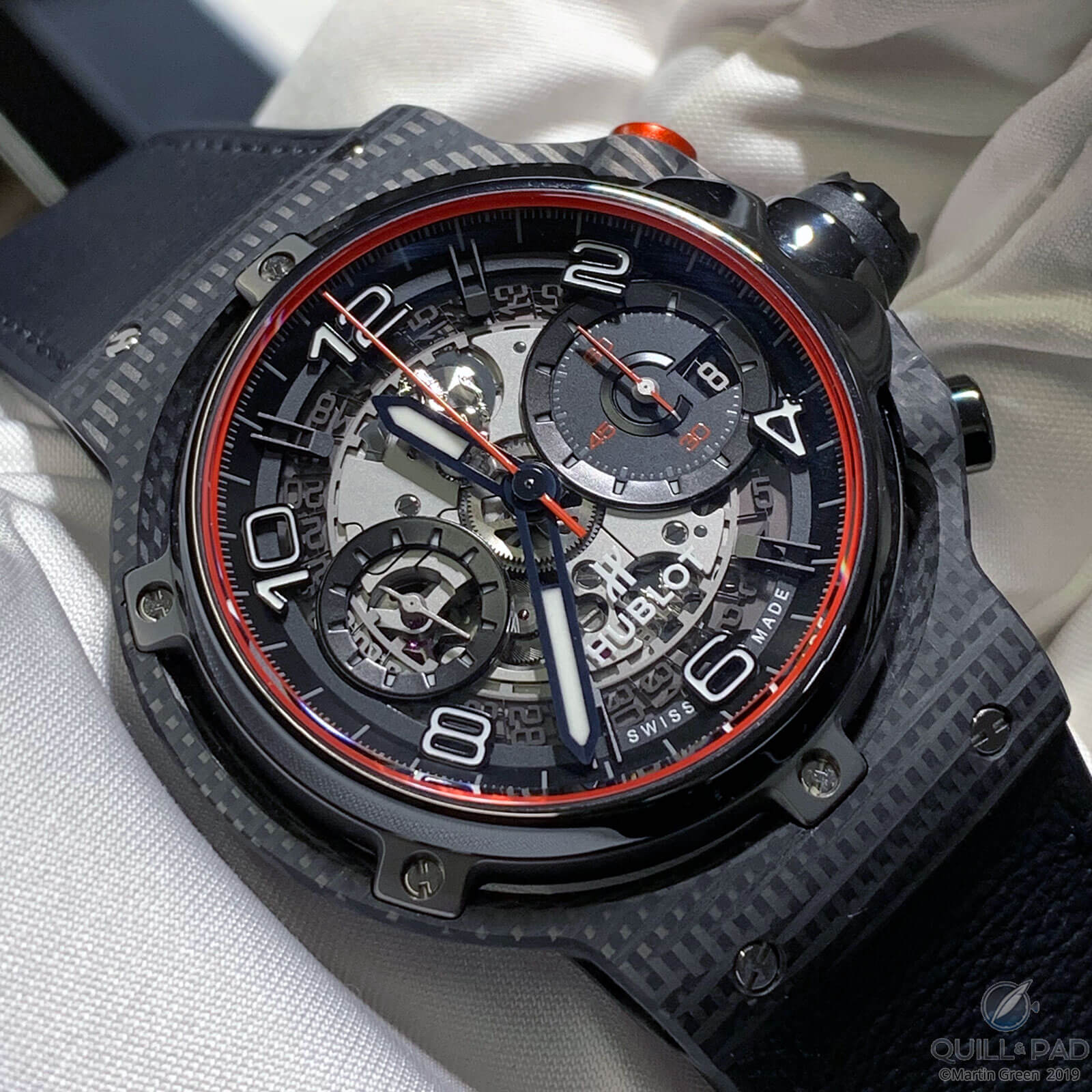
Hublot Classic Fusion Ferrari GT 3D Carbon
MG: With the Classic Fusion Ferrari GT Hublot proves once again that a partnership with a car brand can work very well as long as the two brand “DNAs” are aligned. The fact that this watch’s case is made of 3D Carbon most certainly adds a very distinct character with its pattern.
Further reading:
Hublot Classic Fusion Ferrari GT: The Fourth Time’s A Charm
For more please visit gphg.org/horlogerie/en/watches/classic-fusion-ferrari-gt-3d-carbon.
Quick Facts Hublot Classic Fusion Ferrari GT 3D Carbon
Case: 45 x 13.15 mm, 3D carbon
Movement: automatic Caliber Unico HUB1280, 72-hour power reserve, 4 Hz/28,800 vph frequency, column-wheel chronograph, silicon escapement
Functions: hours, minutes, seconds; date, flyback chronograph,
Price: €26,900/$27,300/25,900 Swiss francs
Louis Moinet Chronosphère
IS: As the inventor of the chronograph (see Discovery, Firsts, And The Louis Moinet Compteur De Tierces), Louis Moinet takes the complication seriously as the Chronosphère highlights. Though 46 mm is too large for me to consider practical for the majority, I particularly like the open dial, skeletonized inverted movement, and retrograde 10-second chronograph counter.
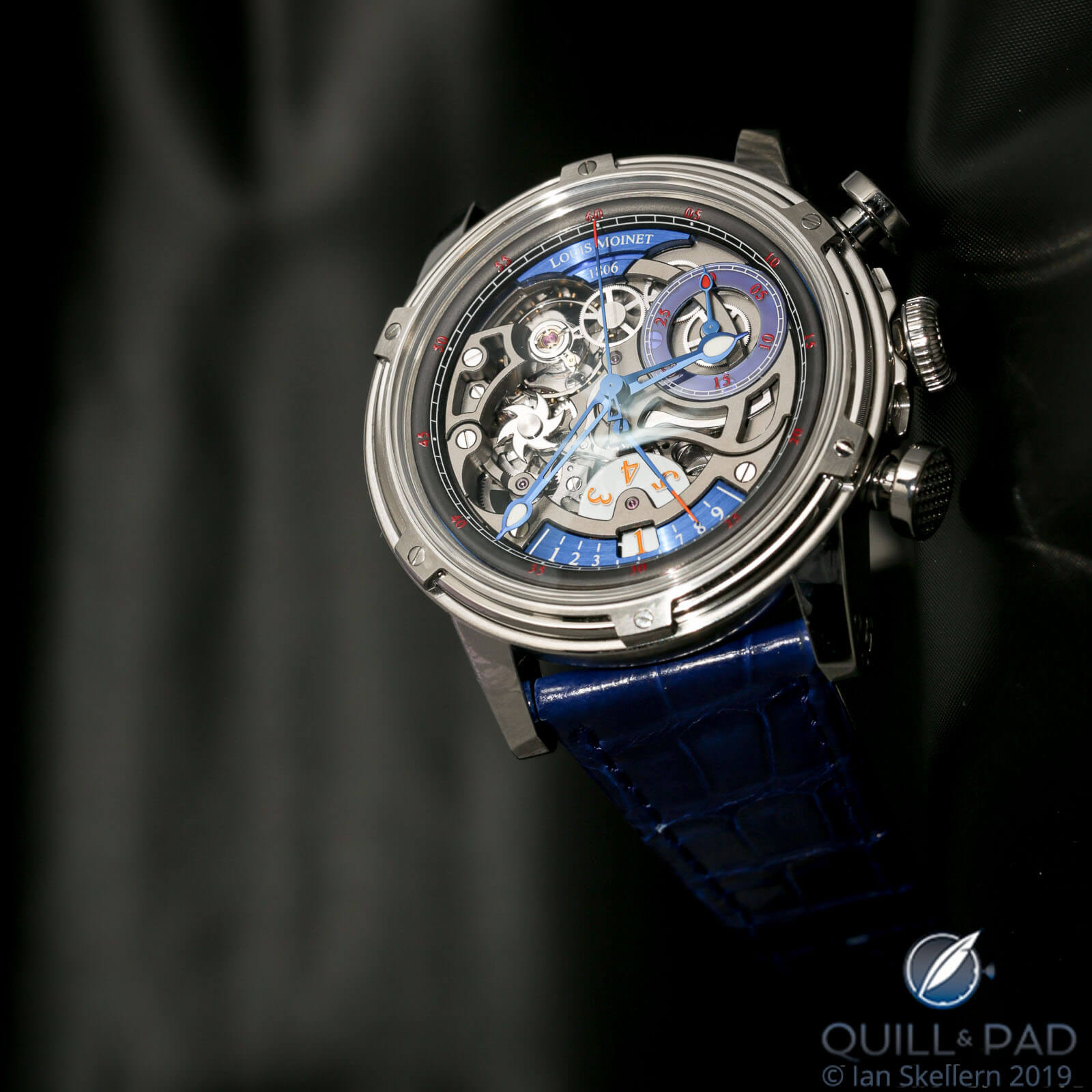
Louis Moinet Chronosphère
SL: I’ve never known quite what to make of Louis Moinet, the brand. It lays claim to producing the first chronograph, although the link between today’s brand and Louis Moinet the watchmaker is in name only. Unfortunately, the brand’s aesthetic doesn’t appeal to me.
TM: Louis Monet makes interesting watches with interesting movements, but design has been a sore point. The Chronosphère is distinctive but lacks both beauty and legibility. It’s very on-brand for Louis Moinet, but the result is a chaotic tangle of shapes and shades that add up to an incoherent whole. External forms are brutal; internal details are random and scattered. At 46 mm, this watch is absurdly oversized for 2019 and feels like a refugee from the show floor of Baselworld circa 2007.
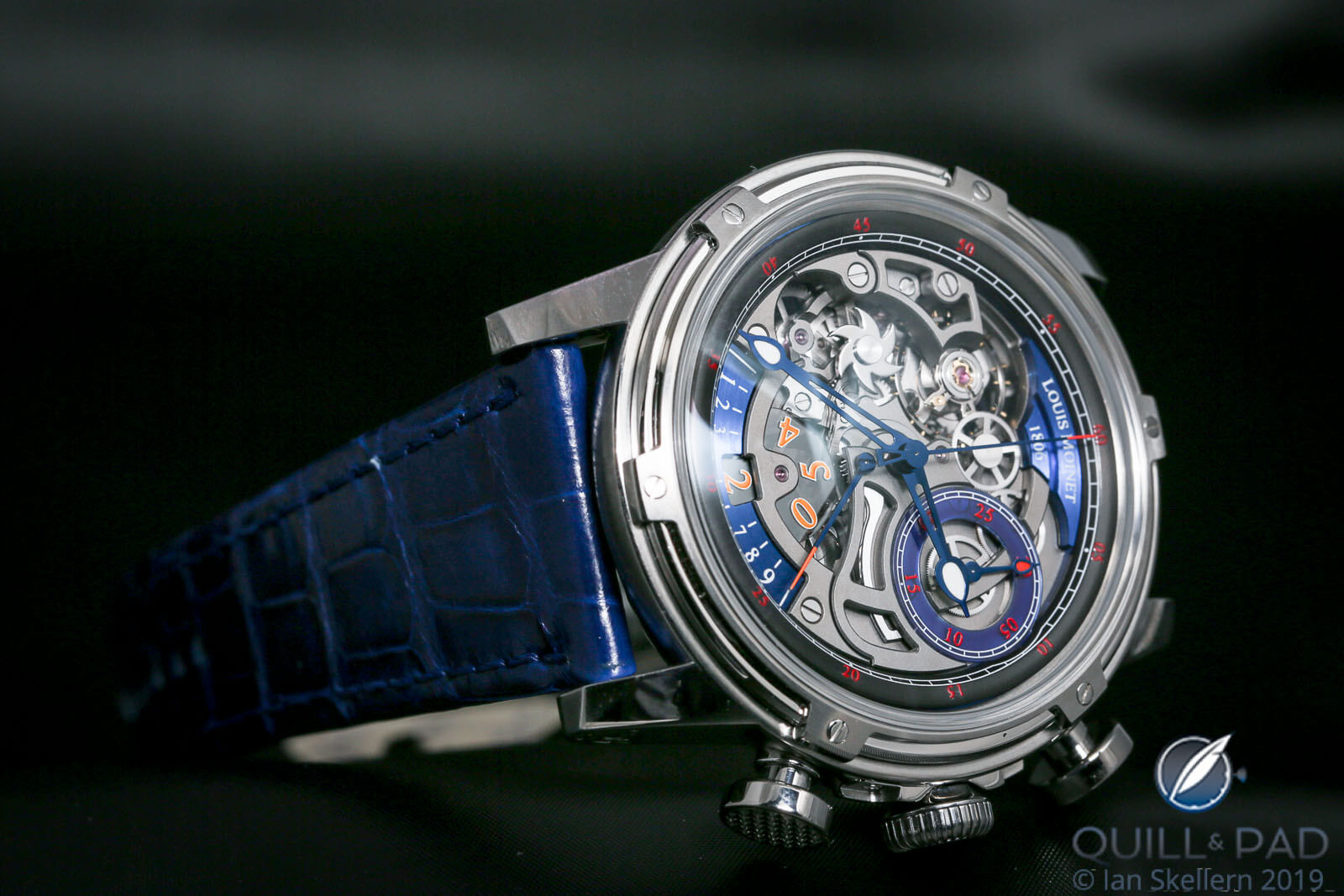
Louis Moinet Chronosphère
JM: This watch is very mechanically interesting and probably my favorite from a mechanical standpoint. I love the fact that it features a ten-second retrograde for the chronograph that displays jumping tens of seconds. The implementation is clever and so very drool-worthy for me that it’s hard for me to say this watch may not be deserving of the top spot.
It all comes down to technical innovation, and while this watch is an awesome mechanical undertaking, it plays within the realm of the conventional engineering in the industry. Granted, the form and function are definitely unique but leaps and bounds in research have been made elsewhere, so sadly this watch must remain a love of mine, but not the winner.
For more please visit gphg.org/horlogerie/en/watches/chronosphere.
Quick Facts Louis Moinet Chronosphère
Case: 46 x 16.95 mm, titanium
Movement: automatic caliber, 4 Hz/28,800 vph frequency, power reserve 48 hours, column wheel chronograph with starwheel slide bar, skeletonized
Functions: hours, minutes, seconds; date, chronograph with retrograde seconds showing jumping tens of seconds
Limitation: 60 pieces
Price: 28,500 Swiss francs
TAG Heuer Carrera Tourbillon Nanograph
JM: My winner has to be the TAG Heuer Carrera Tourbillon Nanograph containing the first carbon composite hairspring, and one that is ready for serial production immediately! Based on a carbon nanotube and amorphous carbon composite, the hairspring is precisely manufactured to any shape necessary, perfectly, every time.
The cost is already relative to traditional metal-alloy hairsprings and represents a major material innovation for stable, antimagnetic, and repeatable non-metallic hairsprings. Next you combine that with the tourbillon, aluminum balance, full carbon fiber case, and the relatively low price compared to anything remotely similar, and this is one tough watch to beat. I will almost always choose the most advanced technology if that is the option, since I want to encourage development in new ideas.
Since this idea was driven by a desire to create, I love it. I think it poses a serious threat to the competition and am predicting that it may take the top spot. Of course, I won’t be sad if the others win.
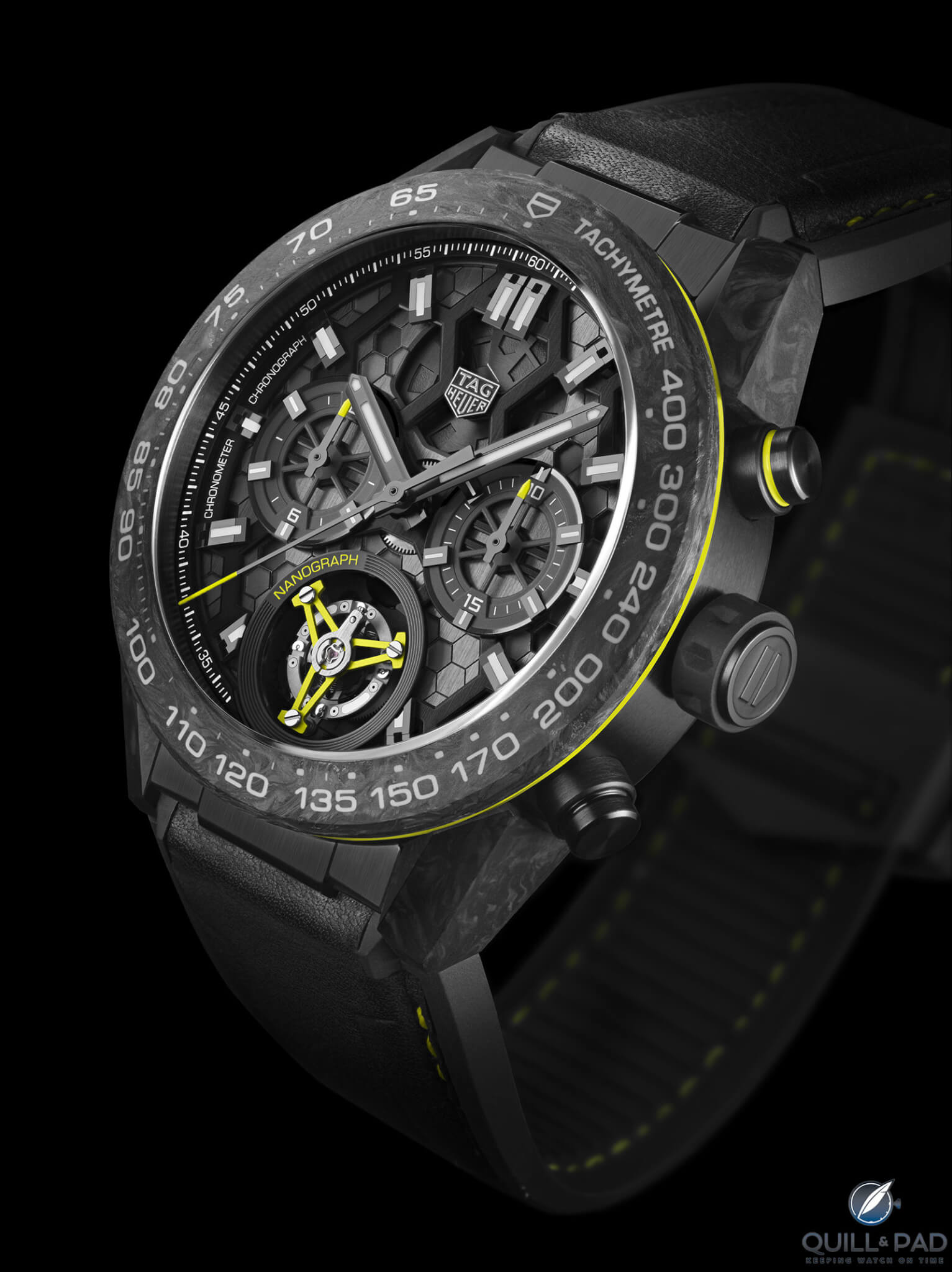
TAG Heuer Carrera Calibre Heuer 02T Tourbillon Nanograph
TM: TAG Heuer’s Carrera Calibre Heuer 02 Tourbillon stunned four years ago with its combination of complications at an unprecedented price point. While CHF 24,900 remains an impressively low price of admission for a chronometer-certified tourbillon chronograph, only the carbon composite hairspring is new for 2019. With three nominations across this year’s GPHG categories, TAG Heuer has better prospects elsewhere than this field: the Nanograph is cool but no champion.
SL: As a lifelong fan of motorsports, I instantly equate TAG Heuer with race timing as its logo has always been so visible, particularly in Formula 1. This bias aside, the Tourbillon Nanograph is interesting on a technical basis, but I think a bit compromised aesthetically.
The skeletonized dial with a honeycomb background comes at the expense of legibility, perhaps emphasized by my progressive presbyopia – I may have liked this watch considerably more when I didn’t need to wear glasses. I’m also mildly concerned that the most interesting part of this watch isn’t the chronograph in itself, but rather the carbon composite hairspring, so another example of a watch that could’ve easily slotted into other GPHG categories.
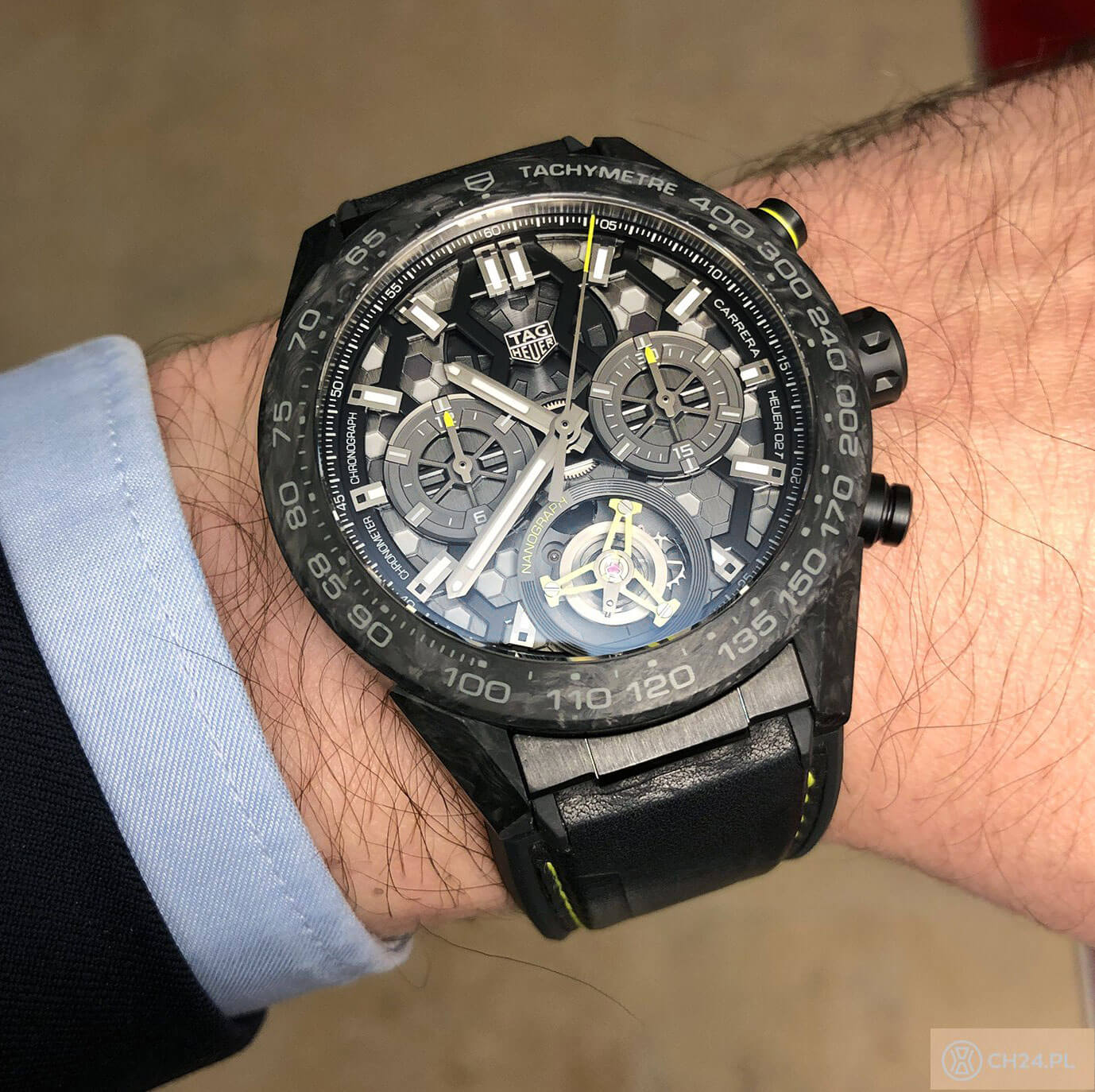
TAG Heuer Carrera Calibre Heuer 02T Tourbillon Nanograph on the wrist (photo courtesy CH24.PL)
IS: Chronographs are all about precision timekeeping, and the ultimate precision of a movement is limited by the precision of the balance, which can be/is affected by shocks and magnetic fields. TAG Heuer’s patented carbon-composite hairspring virtually eliminates those effects so should (theoretically at least) offer better accuracy for both general timekeeping and the chronograph functions. A relatively affordable tourbillon is the icing on the cake. The 45 mm case is on the large size for me, but the TAG Heuer Carrera Tourbillon Nanograph movement makes full use of the space available.
MG: My winner is also the TAG Heuer Carrera Tourbillon Nanograph, Joshua. When introduced in January 2019, it already made quite an impression as a spectacular watch with its chronograph and flying tourbillon complications, but the fact that TAG Heuer is also using it as somewhat of a laboratory to introduce new technologies makes it all the more tempting.
Further reading:
TAG Heuer Carrera Calibre Heuer 02T Tourbillon Nanograph: New Carbon-Composite Tech Offering Big Advantages
For more please visit gphg.org/horlogerie/en/watches/tag-heuer-carrera-tourbillon-nanograph.
Quick Facts TAG Heuer Carrera Tourbillon Nanograph
Case: 45 x 16.5 mm, black PVD titanium and forged carbon
Movement: automatic Caliber Heuer 02T with in-house carbon-composite hairspring, one-minute tourbillon, C.O.S.C. chronometer certification, 65-hour power reserve, 4 Hz/28,800 vph frequency
Functions: hours, minutes, seconds; chronograph
Remark: comes with integrated watch winder in packaging
Price: $25,500/24,900 Swiss francs
Zenith Defy El Primero 21 Carbon
SL: I would’ve been surprised if Zenith had not entered this category, especially given the anniversary of the El Primero. But I wish it had spoken to its LVMH stablemate and not presented a watch that looks, at a glance, so similar to the TAG Heuer. Same comments apply, the skeletonization compromises the legibility. I know some will say that these days we don’t use these watches to do any precision timing, etc. Still, I’d like to be able to see the chronograph readings if necessary.

Zenith Defy El Primero 21 Carbon
JM: My choice for third place is the Zenith Defy El Primero 21, and it’s already a tough call to make because I can easily make good arguments why it should win. The movement inside has twin escapements that beat at dramatically different frequencies: one for time keeping at 36,000 vph (5 Hz) and the other for the chronograph at a lightning-fast 360,000 vph (50 Hz).
That allows the chronograph to measure increments to 1/100th of a second, no small feat. It also features a full carbon fiber case, pushers, and crown for a lightweight yet durable package. Alas, it also is just an updated version of the original model released a couple years ago, so for that reason I had to pass. It is an awesome watch, and a lot for the money, but I have to go with the most recent advances, and this just is not it.
TM: Zenith’s Defy El Primero 21 was a formidable statement of intent in 2017. At the time, it seemed like the lynchpin of a full-fledged brand reboot and re-launch. While subsequent new products have struggled to maintain the momentum, the Guy Sémon-inspired El Primero 21 remains a star. That said, all that’s new for ’19 is a case material and we’ve seen carbon fiber cases before.
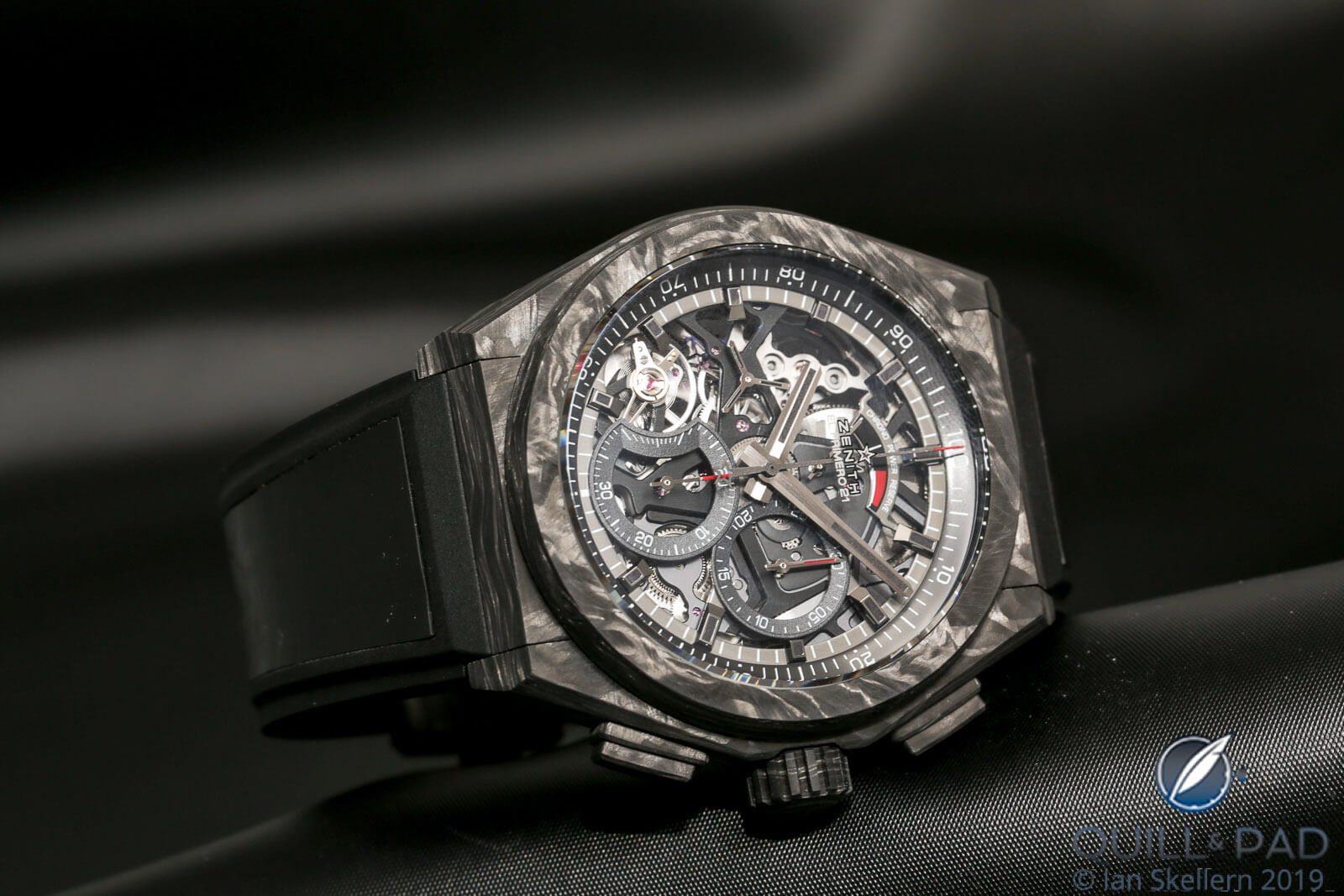
Zenith Defy El Primero 21 Carbon
IS: The evergreen Zenith Defy El Primero, the gift that just keeps on giving year after year. Has there ever not been an El Primero pre-selected in the GPHG Chronograph category? Probably, but it doesn’t feel like it to me. The 5 Hz balance frequency allows for more accurate timekeeping than the industry-standard 4 Hz balance, and the separate 50 Hz (that’s not a typo) balance provides higher precision for the chronograph, which the Defy El Primero 21 Carbon uses to hundredth-of-a-second chronograph timing.
For more please visit gphg.org/horlogerie/en/watches/defy-el-primero-21-carbon.
Quick Facts Zenith Defy El Primero 21 Carbon
Case: 44 x 14.5 mm, carbon fiber
Movement: automatic Caliber El Primero 9004, 5 Hz/36,000 vph frequency (timekeeping)/50 Hz/360,000 vph frequency (chronograph), dual escapement technology, column wheel chronograph, 55-hour power reserve (without chronograph running), chronometer certified
Functions: hours, minutes, seconds; ultra-high-frequency chronograph, power reserve
Price: 18,900 Swiss francs
Predicted Winners
Martin: TAG Heuer Carrera Tourbillon Nanograph
Joshua: TAG Heuer Carrera Tourbillon Nanograph
Sean: Bulgari Octo Finissimo Chronograph GMT Automatic
Tim: Bulgari Octo Finissimo Chronograph GMT Automatic
Ian: Bulgari Octo Finissimo Chronograph GMT Automatic
You may also enjoy:
Our Predictions In The Ladies Category Of The 2019 Grand Prix d’Horlogerie de Genève (GPHG)
Leave a Reply
Want to join the discussion?Feel free to contribute!





















































Yup.
Bulgari for me with the Hublot second and the rest not in the running
I ses bulgari chrono, although this excellent design has been awarded in the past with other complication.
The Monet is the most appealing and fresh. The others look like updated versions of previous technical triumphs. I think Louis should have differentiated it even a little further.